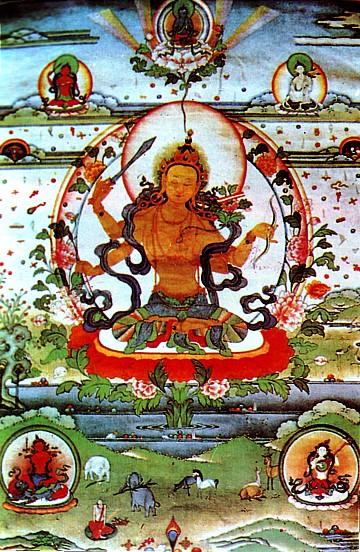Chanting the Names of Manjushri: Difference between revisions
No edit summary |
m (→In Sanskrit) |
||
| Line 25: | Line 25: | ||
===In Sanskrit=== | ===In Sanskrit=== | ||
Three major commentaries (and one further sub-commentary) are presently known to be extant in Sanskrit: | Three major commentaries (and one further sub-commentary) are presently known to be extant in Sanskrit: | ||
*Vilāsavajra, ''Nāmamantrārthāvalokinī'': The first five chapters of this text have been edited and translated by Tribe in ''Tantric Buddhist Practice in India: Vilāsavajra’s commentary on the Mañjuśrī-nāmasaṃgīti'' (Routledge, 2016) | *Vilāsavajra, ''Nāmamantrārthāvalokinī'': The first five chapters of this text have been edited and translated by Anthony Tribe in ''Tantric Buddhist Practice in India: Vilāsavajra’s commentary on the Mañjuśrī-nāmasaṃgīti'' (Routledge, 2016) | ||
*Raviśrījñāna, ''Aṃṛtakaṇikā'': This work, which accords with the [[Kalachakra Tantra]]'s system, has been edited and published by Banarasi Lal in 1994 along with a sub-commentary by Vibhūticandra. | *Raviśrījñāna, ''Aṃṛtakaṇikā'': This work, which accords with the [[Kalachakra Tantra]]'s system, has been edited and published by Banarasi Lal in 1994 along with a sub-commentary by Vibhūticandra. | ||
* ''Gūḍhapadā'', attributed to one 'Advayavakra' (likely Advyavajra), is known to be extant in only one manuscript, namely, Hodgson 34 in the Royal Asiatic Society. This large commentary has not been edited, nor does it appear to have been translated into Tibetan. | * ''Gūḍhapadā'', attributed to one 'Advayavakra' (likely Advyavajra), is known to be extant in only one manuscript, namely, Hodgson 34 in the Royal Asiatic Society. This large commentary has not been edited, nor does it appear to have been translated into Tibetan. | ||
Revision as of 17:38, 24 May 2021

Chanting the Names of Manjushri (Skt. Mañjuśrīnāmasaṃgīti; Tib. འཇམ་དཔལ་མཚན་བརྗོད་, Wyl. ‘jam dpal mtshan brjod) — a famous praise of Manjushri, sometimes known as the 'king of all tantras'. Taught directly by Buddha Shakyamuni, the tantra lists names that praise Manjushri, who is here to be understood not as a bodhisattva but as the embodiment of the primordial wisdom of all buddhas. It consists of 160 verses and mantra sentences.
In spite of the text's length and difficulty, Jamyang Khyentse Chökyi Lodrö famously memorized it after reading it only once.[1]
Text
The Sanskrit text is still extant today. It can be found for example in:
- Wayman, Alex, Chanting the Names of Manjusri: The Manjusri Nama-Samgiti, (Boston & London: Shambhala, 1985).[2]
The Tibetan translation of this text can be found in the Kangyur; it is the very first text of the Tantra section (Toh. 360). It is classified within the Highest Yoga Tantra (Skt. Yoga-niruttara Tantra or Anuttarayoga Tantra; Tib. བླ་མེད་རྒྱུད།, Wyl. bla med rgyud) section. It was translated by Rinchen Zangpo during the 9th century.
- Tibetan text:
 འཇམ་དཔལ་མཚན་བརྗོད་, ‘jam dpal mtshan brjod
འཇམ་དཔལ་མཚན་བརྗོད་, ‘jam dpal mtshan brjod
English Translations by Translator
- Berzin, Alexander, 'A Concert of Names of Manjushri', available here
- Davidson, Ronald M. (ed. & transl.) 'The Litany of Names of Manjushri - Text and Translation of the Manjushri-nama-samgiti', in Strickmann (ed.) Tantric and Taoist Studies (R.A. Stein Festschrift), Brussels: Institut Belge des Hautes Etudes Chinoises (Melanges Chinois et Bouddhiques, vol. XX-XXI) 1981
- Gyurme Dorje, 'The Litany of the Names of Manjushri', included with interlinear commentary in Choying Tobden Dorje's The Complete Nyingma Tradition, Volumes 15-17 (Ithaca: Snow Lion, 2018)
- Tulku Sherdor, 'Professing the Qualities of Manjushri', in The Wisdom of Manjushri (Delancey: Blazing Wisdom Publications, 2012)
- Tribe, Anthony, Tantric Buddhist Practice in India: Vilāsavajra’s Commentary on the Mañjuśrī-Nāmasaṃgīti, 1st edition (London, New York: Routledge, 2016).
- Wayman, Alex, Chanting the Names of Manjusri: The Manjusri Nama-Samgiti, (Boston & London: Shambhala, 1985)
French Translations
- Carré, Patrick, Le Choral du Nom de Mañjusshrî : Arya-Mañjushrî-Nâmasangîti (La Bégude de Mazenc: Arma Artis, 2004)
Commentaries
In Sanskrit
Three major commentaries (and one further sub-commentary) are presently known to be extant in Sanskrit:
- Vilāsavajra, Nāmamantrārthāvalokinī: The first five chapters of this text have been edited and translated by Anthony Tribe in Tantric Buddhist Practice in India: Vilāsavajra’s commentary on the Mañjuśrī-nāmasaṃgīti (Routledge, 2016)
- Raviśrījñāna, Aṃṛtakaṇikā: This work, which accords with the Kalachakra Tantra's system, has been edited and published by Banarasi Lal in 1994 along with a sub-commentary by Vibhūticandra.
- Gūḍhapadā, attributed to one 'Advayavakra' (likely Advyavajra), is known to be extant in only one manuscript, namely, Hodgson 34 in the Royal Asiatic Society. This large commentary has not been edited, nor does it appear to have been translated into Tibetan.
A further twenty three Indian commentaries are available in the Tibetan Tengyur.
In Tibetan
- Ga Rabjampa Kunga Yeshe, འཕགས་པ་འཇམ་དཔལ་གྱི་མཚན་ཡང་དག་པར་བརྗོད་པའི་འགྲེལ་པ་རྒྱུད་དོན་རབ་ཏུ་གསལ་བར་བྱེད་པ་ལེགས་བཤད་ནོར་བུའི་སྒྲོན་མ་, ‘phags pa 'jam dpal gyi mtshan yang dag par brjod pa'i 'grel pa rgyud don rab tu gsal bar byed pa legs bshad nor bu'i sgron ma
- Khenpo Yönten Gönpo, འཇམ་དཔལ་སྒྱུ་འཕྲུལ་དྲྭ་བའི་རྒྱུད་ཀྱི་མཆན་འགྲེལ་རྒྱུད་དོན་རབ་གསལ་ཉི་ཟླའི་སྣང་བ་, ‘jam dpal sgyu 'phrul drwa ba'i rgyud kyi mchan 'grel rgyud don rab gsal nyi zla'i snang ba
- Chone Drakpa Shedrup: གསུང་འབུམ་, Vol. 2, p. 368, རྒྱུད་ཀྱི་རྒྱལ་པོ་མཚན་ཡང་དག་པར་བརྗོད་པའི་སྙིང་པོའི་དོན་འགྲེལ་གསལ་བ།
References
- ↑
 Life of Jamyang Khyentse Chökyi Lodrö by Orgyen Tobgyal Rinpoche
Life of Jamyang Khyentse Chökyi Lodrö by Orgyen Tobgyal Rinpoche
- ↑ Wayman presents the Sanskrit text, alongside the Tibetan and English translations, with elaborate annotations.